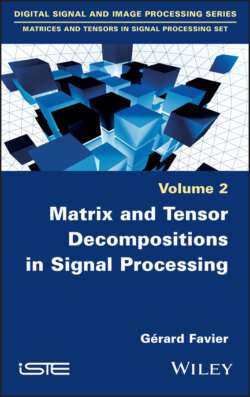Читать книгу Matrix and Tensor Decompositions in Signal Processing - Gérard Favier - Страница 2
Table of Contents
Оглавление1 Cover
4 Introduction I.1. What are the advantages of tensor approaches? I.2. For what uses? I.3. In what fields of application? I.4. With what tensor decompositions? I.5. With what cost functions and optimization algorithms? I.6. Brief description of content
5 1 Matrix Decompositions 1.1. Introduction 1.2. Overview of the most common matrix decompositions 1.3. Eigenvalue decomposition 1.4. URVH decomposition 1.5. Singular value decomposition 1.6. CUR decomposition
6 2 Hadamard, Kronecker and Khatri–Rao Products 2.1. Introduction 2.2. Notation 2.3. Hadamard product 2.4. Kronecker product 2.5. Kronecker sum 2.6. Index convention 2.7. Commutation matrices 2.8. Relations between the diag operator and the Kronecker product 2.9. Khatri–Rao product 2.10. Relations between vectorization and Kronecker and Khatri–Rao products 2.11. Relations between the Kronecker, Khatri–Rao and Hadamard products 2.12. Applications
7 3 Tensor Operations 3.1. Introduction 3.2. Notation and particular sets of tensors 3.3. Notion of slice 3.4. Mode combination 3.5. Partitioned tensors or block tensors 3.6. Diagonal tensors 3.7. Matricization 3.8. Subspaces associated with a tensor and multilinear rank 3.9. Vectorization 3.10. Transposition 3.11. Symmetric/partially symmetric tensors 3.12. Triangular tensors 3.13. Multiplication operations 3.14. Inverse and pseudo-inverse tensors 3.15. Tensor decompositions in the form of factorizations 3.16. Inner product, Frobenius norm and trace of a tensor 3.17. Tensor systems and homogeneous polynomials 3.18. Hadamard and Kronecker products of tensors 3.19. Tensor extension 3.20. Tensorization 3.21. Hankelization
8 4 Eigenvalues and Singular Values of a Tensor 4.1. Introduction 4.2. Eigenvalues of a tensor of order greater than two 4.3. Best rank-one approximation 4.4. Orthogonal decompositions 4.5. Singular values of a tensor
9 5 Tensor Decompositions 5.1. Introduction 5.2. Tensor models 5.3. Examples of tensor models
10 Appendix Random Variables and Stochastic Processes A1.1. Introduction A1.2. Random variables A1.3. Discrete-time random signals A1.4. Application to system identification
11 References
12 Index
